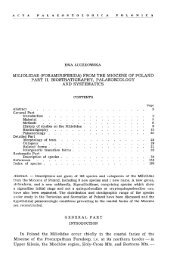The skull of Velociraptor - Acta Palaeontologica Polonica
The skull of Velociraptor - Acta Palaeontologica Polonica
The skull of Velociraptor - Acta Palaeontologica Polonica
Create successful ePaper yourself
Turn your PDF publications into a flip-book with our unique Google optimized e-Paper software.
ACTA PALAEONTOLOGICA POLONICA (44) (2) 201<br />
quadratojugal. <strong>The</strong> medial surface <strong>of</strong> the jugal (exposed in ZPAL MgD-1/97) is angled along and be-<br />
low the ventral margin <strong>of</strong> the orbit to produce a strong ridge, which continues caudodorsally along<br />
the orbital margin <strong>of</strong> the postorbital process <strong>of</strong> the jugal. Rostrally, the maxillary process <strong>of</strong> the jugal<br />
has an extensive medial contact with the ventral extremity <strong>of</strong> the lacrimal. Part <strong>of</strong> this contact is also<br />
overlapped medially by the maxillary ramus <strong>of</strong> the palatine. Below the palatine-jugal contact, the<br />
suborbital ramus <strong>of</strong> the jugal is underlain by the tapering caudal extremity <strong>of</strong> the maxilla. <strong>The</strong> caudal<br />
extent <strong>of</strong> h s contact is along the rostral third <strong>of</strong> the orbital margin. Rostral to the base <strong>of</strong> the<br />
postorbital process <strong>of</strong> the jugal, there is a large depression on the medial surface. At the rostral limit<br />
<strong>of</strong> this depression, the jugal process <strong>of</strong> the ectopterygoid abuts against the jugal.<br />
<strong>The</strong> complete <strong>skull</strong> ro<strong>of</strong> is known only in <strong>Velociraptor</strong> and Deinonychus, but<br />
frontals are known also in Saurornitholestes and Dromaeosaurus. <strong>The</strong> frontals are rel-<br />
atively short and broad between the orbits in Dromaeosaurus, and the orbital portion<br />
<strong>of</strong> the frontal is subequal in length to the postorbital one. <strong>The</strong> adorbital part <strong>of</strong> the fron-<br />
tal is more elongate in <strong>Velociraptor</strong>. In Dromaeosaurus, and possibly also in Sauro-<br />
rnitholestes (fide Currie 1987), there is a slot in the rostrolateral margin <strong>of</strong> the frontal<br />
for the contact with the lacrimal, whereas the articular surface is wide and extensively<br />
overlapped by the lacrimal in <strong>Velociraptor</strong>. <strong>The</strong> holotype <strong>of</strong> S. langstoni, which in-<br />
cludes both frontals, represents an individual <strong>of</strong> similar size to GIN 100125 (the maxi-<br />
mum widths across the frontals are somewhat over 60 mm in both specimens). <strong>The</strong><br />
interorbital width <strong>of</strong> the paired frontals (measured just behind lacrimal contacts) is<br />
about 70% <strong>of</strong> the maximum frontal length in Saurornitholestes, but is only about 50%<br />
in <strong>Velociraptor</strong>. <strong>The</strong> caudal portion <strong>of</strong> the frontal is somewhat bulbous centrally in<br />
Sauronitholestes, but it is only very weakly convex in all <strong>skull</strong>s <strong>of</strong> <strong>Velociraptor</strong> at our<br />
disposal.<br />
As in Dromaeosaurus (Currie 1995), the nasal in <strong>Velociraptor</strong> extensively overlaps<br />
the frontal, differing in this respect from Saurornitholestes, in which the nasal-frontal<br />
contact seems shorter. Parietals are fragmentary in Dromaeosaurus. A striking feature<br />
<strong>of</strong> the lacrimal in <strong>Velociraptor</strong> is its slender and greatly elongated rostral process (it<br />
reaches almost to the mid-length <strong>of</strong> the long nasal). Although the external edge <strong>of</strong> the<br />
lacrimal seems smooth in the holotype <strong>of</strong> V mongoliensis, in all <strong>skull</strong>s at our disposal<br />
the orbital margin <strong>of</strong> the lacrimal is somewhat thickened and rough. <strong>The</strong> lacrimal in<br />
Deinonychus also has the long rostral process (Dr L.M. Witmer's personal communi-<br />
cation 1999). <strong>The</strong> shape <strong>of</strong> the lacrimal attributed to Utahraptor is distinctive in dorsal<br />
aspect, because it lacks the lateral projection, and is rather rectangular (not triangular<br />
as in <strong>Velociraptor</strong> and Deinonychus). In Dromaeosaurus only fragments <strong>of</strong> the lacri-<br />
mal are known. However, also in this genus the lacrimal does not contact the maxilla<br />
ventrally. Lack <strong>of</strong> the ventral lacrimal-maxilla contact is a common character <strong>of</strong><br />
theropods, the rare exceptions known to us being Eoraptor (Sereno et al. 1993),<br />
Syntarsus rhodesiensis (fide Colbert 1989), Ceratosaurus (Gilmore 1920), Allosaurus<br />
(Madsen 1976) and Compsognathus (Ostrom 1978). <strong>The</strong> prefrontal is absent (or com-<br />
pletely fused with the lacrimal) in <strong>Velociraptor</strong>, while it is a separate bone in Deino-<br />
nychus and probably also in Dromaeosaurus. In the presumably embryonic dro-<br />
maeosaurid <strong>skull</strong>s (probably representing <strong>Velociraptor</strong>) preliminary described by<br />
Norell et al. (1994), the prefrontal is absent, which according to these authors contra-<br />
dicts the idea that the prefrontal was fused to the lacrimal.<br />
<strong>The</strong> squamosal process <strong>of</strong> the postorbital is almost parallel to the long axis <strong>of</strong> the<br />
<strong>skull</strong> in Deinonychus showing but negligible outward inflexion, while this process dis-

















